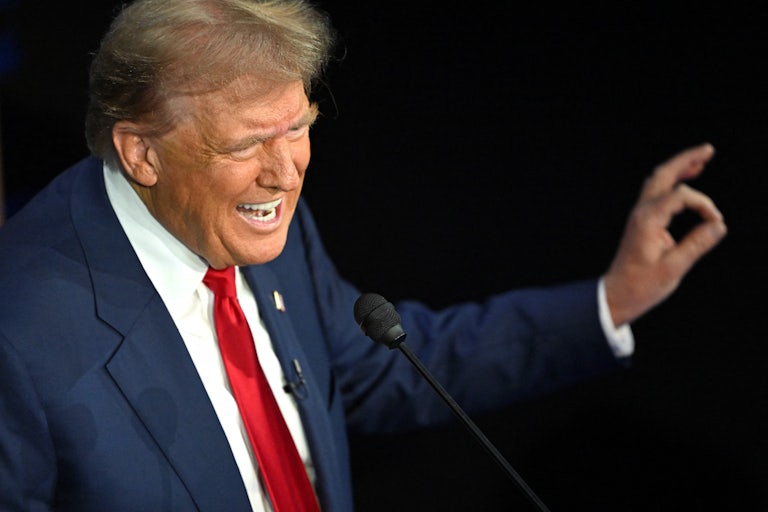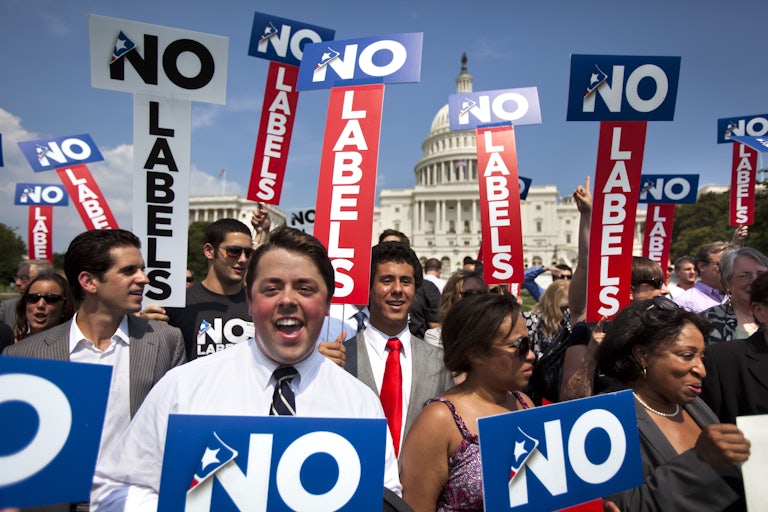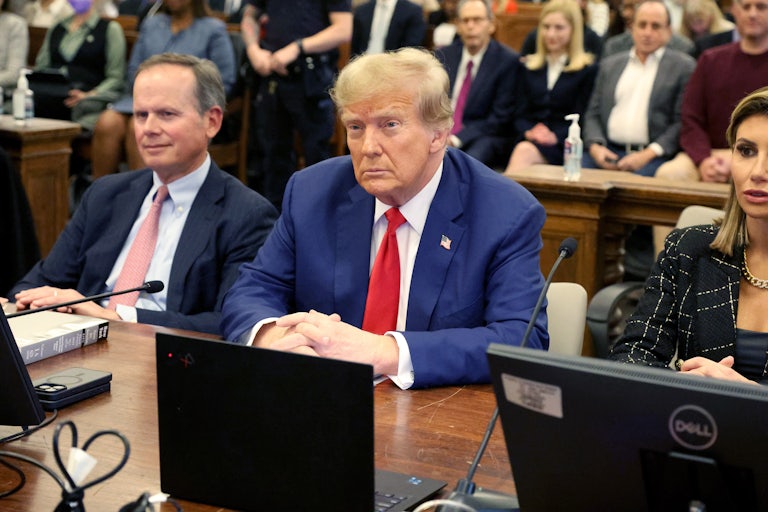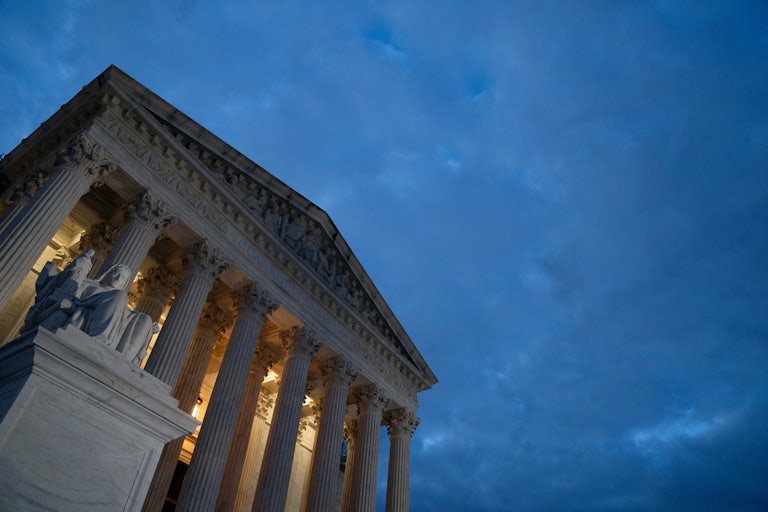Trump Won on Immigration
The former president may not get to implement his draconian deportation plan, but he’s successfully dragged Democrats and public opinion in a less humane direction.

If Donald Trump has a singular policy proposal that he’s planning on implementing upon his return to Washington, it’s probably his bruising and “bloody” mass deportation of tens of millions of people from the United States. Kamala Harris understands that what Trump is proposing is frightening, darkly warning on Wednesday that the plan could herald massive raids and deportation camps. But even as she takes this message to voters, her own position on immigration is, as The New York Times characterizes it, “a balancing act.” It’s important to identify what, precisely, she’s trying to balance, though: on the one hand a desire to appeal to immigration restrictionists and on the other a moral imperative to treat migrants fairly and humanely.
It’s an odd situation for Democrats to be in, considering that draconian immigration policies are Trump’s bread and butter—to say nothing of his habitual demonization of migrants and immigrants. If something in the Democratic response seems to be sputtering, however, that’s probably indicative of a sad reality: One of Trump’s big political successes was his dismantling of the polite Beltway consensus on immigration reform and taking public opinion with him.
If Trump implements his mass deportation scheme, it would be perilous for just about everyone. As the Washington Monthly’s Robert Shapiro reported last May, the proposal would be economically calamitous—damaging to key industries and certain to “bring on a recession while reigniting inflation.” But Shapiro points to something else beyond the economy that seems like it might leave a deeper wound: “MAGA attacks on immigration also draw on common fallacies and reckless misrepresentations. For example, the vast majority of unauthorized immigrants have deep ties to their communities and the country.”
This is the heart of the matter: a plan to harm both immigrants and the communities that have taken them in. If you’d like to get a feel for what it looks like when Trump is carving up the U.S. population, one need only look to Springfield, Ohio, which has become a microcosmic example of the former president’s larger design. There we’ve seen the Trump-Vance campaign concoct and stoke lies, for the purpose of putting a town on edge and fomenting mass paranoia and the tormenting of the Haitian community, who settled within the city limits on the promise of well-paying jobs and helped revive their town. Trump’s efforts have led to the bullying of these immigrants and chaos throughout the community, with leaders futilely trying to stem the tide of the campaign’s meretricious lies while contending with bomb threats and other violence.
Haitians are the epitome of a vulnerable group, having arrived here after “fleeing a series of disasters, both natural and man-made, many of them exacerbated or caused by the government and industries of the U.S.,” as TNR contributor Jonathan Katz wrote this week. The way the Haitians of Springfield have been depicted by Trump and his MAGA allies is especially grotesque, and might be more than mere campaign trail politicking: Engendering public animus toward immigrants is a soft launch of sorts for Trump’s mass deportation project—which, as Mother Jones’ Isabela Dias reports, is going to target not only undocumented migrants but legal ones too.
The Haitians facing Trump’s slings and arrows could use a champion. So far, however, Harris hasn’t exactly been their fire-spitting defender. In their debate, Harris passed on an opportunity to take Trump to task for his racist attacks on Haitian Americans, offering only a throwaway comment (“Talk about extreme”) before pivoting; a second chance to assail his deportation plan more specifically ended with Harris roasting Trump for the criminal charges he’s racked up since leaving office. More recently, at a National Association of Black Journalists confab, Harris expressed support for the larger Springfield “community” without actually naming the segment of that community who are facing the full force of her opponent’s cruelties.
None of this is likely demonstrative of some personal animus that Harris holds toward Haitians in general—though her omission does recall an incident from the 2020 campaign in which the Haitian American community in Miami was left feeling slighted by a Harris campaign visit. It’s more in keeping with a deep skittishness that has permeated the campaign, most likely through the advisers she’s inherited from Biden. But it’s also a timidity that elite Democrats all seem to share on the issue. I was never very confident that Trump’s ouster was going to catalyze much of a reversal on Trump’s immigration policy. As reporters like TNR contributor Felipe De La Hoz have continually reported during its tenure, the Biden administration has been disappointingly predictable.
As Axios reports, the progressives who want a clean break with Trump’s immigration designs are hoping that Harris’s recent hawkish stance is a temporary measure, born out of (an assumed) necessity of the campaign trail. It’s hard to fathom from where they derive this hope. Democrats haven’t exactly blazed a path away from Trumpism. Harris herself is still taunting the GOP for following Trump’s orders to kill the Biden-favored immigration bill that, had it been enacted, would have left these hopeful progressives bereft.
And as Washington bends in the direction of more draconian immigration policies, the public seems to have become more cemented on Trump’s side of the issue. According to a September 18 Ipsos poll, more respondents “believe former President Donald Trump would do a better job handling immigration than Vice President Kamala Harris, and Americans broadly do not understand what Harris’ role is, related to immigration.” And while “most support giving a pathway to citizenship for undocumented immigrants who arrived in the U.S. as children,” there is also majority support for some form of “mass deportation.”
It’s amazing how things change in such a short amount of time. During the Obama administration, Democrats and Republicans took comprehensive immigration reform seriously and tried to find common ground to create a more sensible, secure, and decent way of admitting people into this country. When Mitt Romney pledged to lead a wave of voluntary self-deportation, his proclamation was considered harsh and embarrassing—the fumbling attempts of a dyed-in-the-wool technocrat courting the fringe. Now Trump wants to banish tens of millions of immigrants, including an untold number of legal citizens, and it’s raising surprisingly few hackles.
There is obvious comfort to be taken in the fact that Harris doesn’t share these extreme views and—I think!—doesn’t share Trump’s love of disappearing a huge portion of the populace. But Trump has drastically shifted the Overton window, and Democrats have done almost nothing to arrest it. The aspirations of comprehensive immigration reformers seem all but dead, and the future of humane immigration policies is bleak indeed. We might as well say it, if only because admitting we have a problem is the necessary first step in solving it: Trump won.
This article first appeared in Power Mad, a weekly TNR newsletter authored by deputy editor Jason Linkins. Sign up here.









